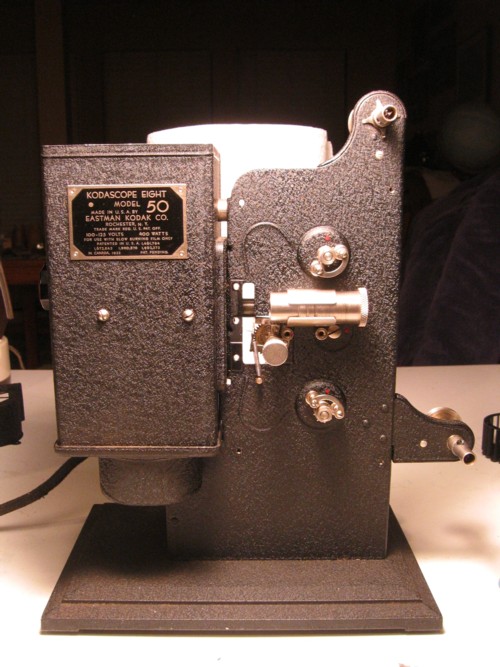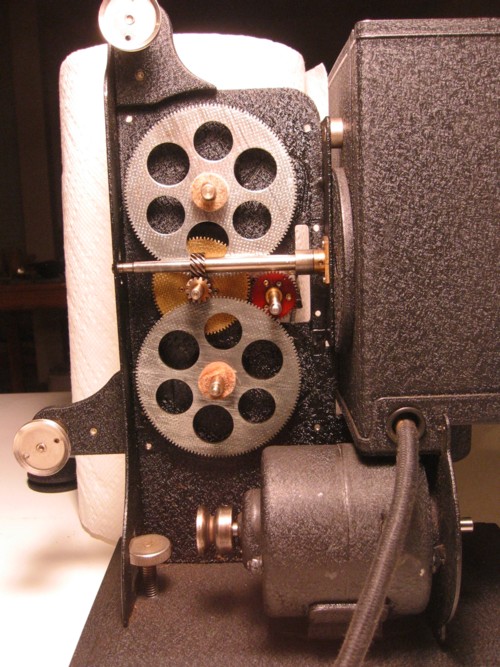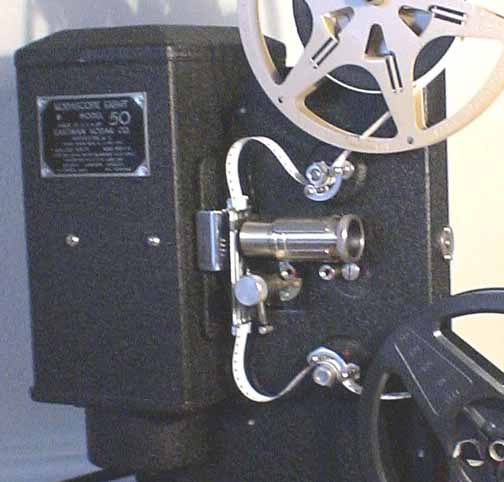This is topic kodascope eight model 50 projector in forum 8mm Forum at 8mm Forum.
To visit this topic, use this URL:
https://8mmforum.film-tech.com/cgi-bin/ubb/ultimatebb.cgi?ubb=get_topic;f=1;t=007385
Posted by Dick Bemis (Member # 3234) on August 21, 2012, 06:33 PM:
I have been handed down from relatives a kodascope eight model 50 projector with plenty of 8mm home movies. I assume it was working before I got it but don't know for sure. The light and motor works and everything appears to be working, but when I thread the film in from the top reel both sprockets, top and lower, rotate counterclockwise while the frame gate is moving the film down. The film through the frame gate and sprockets are moving in opposite directions. Am I missing something or does this projector have a problem? I would appreciate help from someone that has this projector or is familiar with my problem. If I put the film in backwards on the sprockets it sort of works but the film rubs on the lens casing.
Posted by Joe Taffis (Member # 4) on August 21, 2012, 07:58 PM:
Hi Dick, and welcome to the Forum. From the picture I've seen of that model your film should feed down and between the top sprocket wheel and the metal guard/guide, (the film) going UNDER the wheel. Then again between the lower sprocket wheel and guide, while going OVER the lower wheel. The problem may also have something to do with how the spring belts on the back of the projector are placed. Some of these real old projectors required moving a belt or belts to different positions for certain functions, like rewinding. Both sprocket wheels should be turning clockwise when running a film forward. Hope this helps.
Posted by Dick Bemis (Member # 3234) on August 22, 2012, 12:32 PM:
Thanks Joe,
You have described the way I also think it should work, but it doesn't. If I change the motor drive belt it changes the film direction and also the sprocket direction. Changing any other drive belt doesn't help. I even looked inside to see if anything could have been changed in the past to make it work this way. Nothing stands out. The only guess I come up with is the cam on the pulley that drives the frame gate was installed backward at the factory. That's not logical since I assume it was used in the past. I've already spent more time on it then it's worth. I can buy another used projector fairly cheap, but it is driving me crazy not knowing why it doesn't work. Thanks for your help.
Dick
Posted by Joe Taffis (Member # 4) on August 22, 2012, 10:14 PM:
Did you try running a film forward with NO belt attached to the top spindle? Only from the motor to the lower take-up spindle? I'm thinking that maybe you only need the belt on the top one when rewinding a film.
Posted by Hugh Thompson Scott (Member # 2922) on August 23, 2012, 01:08 PM:
Is there any way a picture of this machine could be uploaded
that we can peruse and hopefully find a solution to Dick's problem.
Posted by Joe Taffis (Member # 4) on August 23, 2012, 05:20 PM:
Believe it or not I just found a video on YouTube with one working...I don't know how to post a link, but the user's channel is IMULL3. The video is titled "thrift store score, kodascope eight model 50 8mm projector"
Posted by Dick Bemis (Member # 3234) on August 23, 2012, 07:35 PM:
Thanks for all the input. Somebody was reading my mind. I took pictures last nite. I've also seen video with it working. It is hard to tell from the video's what is happening with the frame gate. My projector appears to turn different then videos. Why? You are probably right that no belt is needed on the top spindle except maybe to keep tension on it. 

The front side of projector is with the film gate removed. The back side of projector is with the cover removed showing all of the gears. I do not see anyway it could be modified from the factory causing it not to work.
Posted by Paul Adsett (Member # 25) on August 23, 2012, 08:11 PM:
I have a fully functional Kodascope 8 50. This photo shows how it is threaded, with the film going under the top sprocket, and over the bottom sprocket.

It is important to twist the belt coming off the drive motor so that the main drive pulley is running in an antti-clockwise rotation when looking at the pulley from the back of the machine.
The supply reel belt and take-up reel belt are not twisted.
Posted by Dick Bemis (Member # 3234) on August 23, 2012, 08:54 PM:
Paul, that is a good picture. I've setup the film in the projector exactly like your picture. When the film is being feed from the top spindle and sprocket into the gate, the film gets pushed back up. The gear at the gate has a cam that rotates pushing up the film. I've been trying to get that gear out to see if the cam is reversed. It looks like it is fixed onto the gear.
Posted by Dick Bemis (Member # 3234) on August 24, 2012, 12:57 AM:
The mystery is solved. I pulled the gear that had the cam which moves the arm that advances the film. After playing around with it a while I realized the other further away in line gear also had a cam. If the gears aren't in the correct alignment the film can go in the opposite direction. The gears some how got out of alignment with each other. It took a while with a lot experimenting, but I finally got it. The closest cam gear moves the pointer up and down while the other cam advances it in and out of the film holes.
The projector is well built. The machine has a simple design but will last forever because of its built in precision quality.
It will probably work for many more years. Thanks for all the help.
Dick
Posted by Hugh Thompson Scott (Member # 2922) on August 24, 2012, 03:08 AM:
A beautiful piece of engineering that is a breath of fresh air in
this throwaway world of fast technology.I'll warrant prints that have been put through these little machines are as good as the day they were taken.Thanks for those lovely pics.
Posted by Paul Adsett (Member # 25) on August 24, 2012, 09:19 AM:
Hi Hugh,
Yes this little machine is a throw back to a time when things were built to last. The Kodak 50 is vintage 1936. Even this very basic projector has rugged ,quality construction. No plastic parts to break off on this machine! It even has a centrifugal shutter, which blocks light from the lamp if the projector is not up to speed, thus eliminating film burning. I also have a Pathe Baby from 1922. Both these projectors still run perfectly, and will undoubtedly last another 100 years or more.
Contrast that with a video projector I purchased 7 years ago. It needs a new polarizer (parts cost about $100.00) but the manufacturer will not just do a polarizer replacement, they have to replace the whole optical engine of the projector as this is designed as a throw away assembly. Cost about $1,000! So its cheaper to throw away a perfectly good projector and buy a new one, than to repair it.
Posted by Hugh Thompson Scott (Member # 2922) on August 24, 2012, 10:32 AM:
You're absolutely right Paul, it really makes me angry when we get
all this rubbsh from governments on re cycling,and they actually
encourage this kind of thing.As you rightly say,that little machine
was made at a time when longevity was the thing and people
took a pride in making something that gave good service.
Posted by Janice Glesser (Member # 2758) on August 24, 2012, 12:12 PM:
That is a beautiful projector Dick and I'm so glad you solved the mystery. Excellent job!
Posted by Paul Adsett (Member # 25) on August 24, 2012, 03:31 PM:
Just finished running a reel of film thru my Kodascope model 50.
Hard to believe this projector is 75 years old, it runs like new. It really is a sweet little machine, and projects a rock steady sharp picture, albeit on a smallish screen. When you run one of these pre-halogen mains voltage lamp machines, you really appreciate what a quantum leap the introduction of low voltage halogen lamps and fast projection lenses was to 8mm in the 1960's.
Posted by Dick Bemis (Member # 3234) on August 26, 2012, 07:57 PM:
Well, the projector is running like a champ. Even a novice like me can run it. I got to view many home movies as old as the projector. I didn't expect much but was disappointed with the quality of the movies. Everyone appeared eager to be in the movies. Just to be able to see your self in movies back then was something. Technology has come a long way. I'm hoping the more recent movies that I haven't seen yet were taken with a better camera. The movies are from my wife family. Of course no one in the movies is still alive. I thought if I found something worthwhile I would try to scan the film just like I have done with slides. Has any one tried that?
My background is electronic engineering. My jobs involved problem solving and fixing things that were broken or never worked as designed. It is in my blood to fix things. I have fixed many items which broke soon after buying. I also hate to throw stuff away, so I spend more time fixing things rather then buy another that will probably also break.
Dick
Posted by Paul Adsett (Member # 25) on August 27, 2012, 08:49 AM:
Dick,
The Kodascope 50 was a good little projector for its time (1930's), but in no way represents the quality of 8mm projection that can be obtained with a more modern machine. The 1960's and 70's saw multiple breakthroughs in 8mm projection, chief among them being the introduction of low voltage halogen lighting and the use of very fast and very high quality lenses for both camera and projectors. The difference betwen your 1930's Kodascope and say a Bolex 18-5 from the 1960's is literally like night and day.
Also, there were many cheap and nasty 8mm cameras on the market, that certainly did not do justice to 8mm. But films shot on high quality camera, such as the 8mm Bolex cameras for example, will knock your socks off when you see them, and will generally put digital video to shame.
And, of course, you have to remember that shooting good quality film was a skilled process back then. There was little or no automation in the camera, so you had to understand things like film speed, shutter speed, lens aperture, depth of focus etc.
For people who took the time to master these things, and who used good quality equipment, the results on the screen were often breathtaking.
Posted by Bradley Gilliland (Member # 4928) on May 09, 2017, 01:35 PM:
I have a kodascope eight model 50 and I'm having problems with the centrifugal shutter running backwards. But everything else is running in the right direction.
Visit www.film-tech.com for free equipment manual downloads. Copyright 2003-2019 Film-Tech Cinema Systems LLC

UBB.classicTM
6.3.1.2


